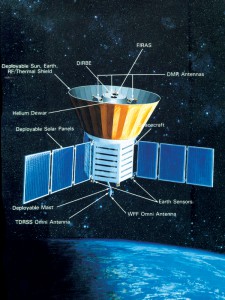
Altogether you spent close to 30 years of your career at Goddard. Developing a satellite like COBE, which has made enormous scientific contributions, must’ve been a huge accomplishment for both you and the Center.
It was. We were involved in Nobel-type science. COBE was an in-house program where they were developing the best they could develop. That has its upside and its downside.
The upside can obviously be seen in the success of COBE. Can you talk about the downside in this type of project?
Let me explain it this way: there’s an analogy I use when I give talks about these programs. I think of them as essentially having three “pieces” — a spacecraft, the instruments, and the ground system. When all three are new designs, it just iterates, and iterates. Now combine that with the fact that it’s an in-house program, and it’s difficult to stick to a schedule. The reason is that in-house programs are always looking for the “ideal” design.
In my experience, it’s an in-house mantra: develop the best, because our projects are one-of-a-kind, and we only do them once. It has to be the best we can possibly do, and our hardware has to have all brand new designs. When you get into this kind of thing, you can hardly ever complete the project. Then the management team gets criticized, because it can’t get done.
This is different from your experiences on other programs?
It was much different when I went to Johns Hopkins University to manage the Far Ultraviolet Spectroscopic Explorer (FUSE) in the late ’90s. The spacecraft and the ground station were bought off-the-shelf. Both were fixed-price contracts. The only thing that was iterated was the instrument. When you only iterate one “piece” and the other two are fixed, you can get it done much quicker and at cost.
Since COBE was in-house, how did you keep the team from continuing to search for that “ideal” design?
When we redesigned COBE for a Delta ELV after the Shuttle Challenger accident, we froze the spacecraft design. We selected the ground system and said, “We’re going to go with what we’ve got; no more changes.” It made a difference.
If we hadn’t done that, it could’ve gone on much longer. An in-house program is sometimes like a sandbox where everyone gets to keep playing and experimenting. Many in-house people have the attitude of “We want to build the best. It’ll be done when it’s done.” Those same people expected me to let them play, and then to periodically go to Headquarters to get more money to fund it. That wasn’t my job, but that’s their philosophy.
Is this a problem particular to your project and Center, or do you think that project managers always have to fight for control of their respective projects?
It happens in other places as well. I sat on a review board for Mars Pathfinder and Project Manager Tony Spear. He had formed a Skunk Works on his project, and I’m thinking, “This looks familiar.” He was trying to control the Jet Propulsion Laboratory (JPL).
I met with him privately before the review. I said, “Tony, what can I do to help you? I’m not just here to look under rocks and find things you’re not doing, because you don’t have the time or money.” It was a surprise to him, because no one had ever asked him what he needed in a situation like that. He told me he needed control of the people that work in a matrix organization at JPL.
And did you take action?
Yes. I got up in front of the Deputy Administrator and all of the Associate Administrators and said that I believed that Mars Pathfinder would work. I went out on a limb, but I supported it as an engineer. Then I said that there’s one thing he needs, and that is control of the people in the matrix organization at JPL. I said, “I strongly suggest and recommend that he co-sign their performance.” And the Associates agreed with me.
Would it have been possible for you to have tried a technique like co-signing on COBE?
No, no. The in-house people would never give up control of their people on the project. Some of them thought we were just the source of funds for their sandboxes. When that’s the case, it’s a terrible environment in which to try to build flight programs on schedule. That’s the way it was for me until the Shuttle accident in 1986. Then we had priority at the Project Office, and we were given the requirement to get it done on time. We eventually got the Center to do it our way, but it annoyed a lot of people. A lot of people still wanted to do it the old way.
How did you get around that?
In our case, it took a crisis like the Challenger explosion to get more control. When the accident happened, we couldn’t find a way to launch COBE. I was working hard to find another rocket, evaluating every launch vehicle in the world from the Chinese to the European Arianne. NASA Headquarters was naturally embarrassed, because here was this premier science satellite that we were going to build and launch from a rocket in another country.
So they found a way to launch it domestically?
The Associate Administrator looked around and found one Delta-1 rocket left, and it was old — the last one ever built. They said we could use it.
And it was possible for COBE to launch on a smaller rocket?
Well, the satellite originally weighed close to 12,000 pounds. However, if it wasn’t launched on the Shuttle, it wouldn’t need the 5,000-pound propulsion system. It also wouldn’t need the 3,000-pound structure that held it across the Shuttle’s cargo bay. So I figured we could fold everything up like the Mars Rover and launch it at about 5,000 pounds from a Delta.
NASA looked at the figures and agreed to launch it from the Delta?
They decided to do it. Noel Hinners, Goddard’s Center Director, got behind us. He said, “This program will be the centerpiece of Goddard for the next 3 years. It will have all the priority needed.” That’s what got us really moving.
For those of us who used to work there in the 1960s, it made us remember a time when we used to just do things. Back then we didn’t have so many processes, procedures, and reviews. We just built things. We were always saddened in the ’80s that the younger people had no idea you could do things like that.

Annual average maps created from information retrieved from the Diffuse Infrared Background Experiment (DIRBE), one of COBE’s three instruments.
So, this was a great model for the younger professionals to see that when the system focuses on a specific goal and clears the barriers away, that you can get it done. In our case, our barriers were cleared by an unfortunate crisis. Without the attention the project got from losing the Challenger, and without some pushing on the system on my part to find another way to launch, it would’ve died. COBE would have faded into the woodwork, and everyone would’ve forgotten about us.
Was it always you and the Project Manager against the system, or did your team back you?
They did, and it really didn’t take long. But it started out with control. When we formed the Skunk Works, we said, “We’re in complete control of this project; we’ll decide when you get it done.” We met with everyone each week in the war room. We just took over.
Then, after a year and a half of a 3-year Skunk Works, the workers tend to take over. I worked half that time trying to move just an inch forward every day. After a while, they look up, and we’ve moved five feet. And the workers want to finish the job; they get a look in their eye. My goal then was to get out of their way — to give them what they needed and let them go.
How did you get the workers who wanted to “develop new technology” to shift their focus to meeting time and money constraints?
We just showed them that we were in control of the project. We said, “We’re not asking any more questions. We are going to get this done.” It didn’t take long for the workers to throw the switch. Once it clicks that this is not going to be the run-of-the-mill sandbox — where we’re just going to develop new designs — they want to get it done. It’s psychological.
What exactly was the Skunk Works strategy that set all this in motion?
We co-located everyone in one building, all of the engineers, and we put offices in. The core team was about 3-dozen people. They were working for us for the next two and a half years, which was hard since their matrix home was somewhere else. But we said, “We’ll send them back when we’re done.”
We had a big “war” room and met there each week so there could be frequent and direct communication. We put every schedule on the wall, with the name of a different team member on each one. That schedule was their responsibility. I told them, “That’s not my schedule up there, that’s yours.”
If you empower people, then they feel responsible. My philosophy was to delegate and empower people. To me, that’s the job of the project manager: empowering and removing obstacles.
This must’ve been an amazing opportunity for some of the people you empowered.
They still talk about it. There is a street sign at Goddard that says COBE Road. It was a huge project spanning seven years. The fact that they did it after the Shuttle accident, it was the first NASA science mission, and they did it in Skunk Works…it’s really satisfying. They kept to a schedule, they got empowered and took responsibility, and they ultimately made the project a success.












